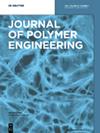Enhancing the Performance of Polylactic Acid (PLA) Reinforcing with Sawdust, Rice Husk, and Bagasse Particles
IF 1.2
4区 材料科学
Q4 POLYMER SCIENCE
引用次数: 0
Abstract
Polylactic acid (PLA) is the most popular thermoplastic biopolymer providing a stiffness and strength alternative to fossil-based plastics. It is also the most promising biodegradable polymer on the market right now, thus gaining a substitute for conservative artificial polymers. Therefore, the current research focuses on synthesizing and mechanical characterization of particlereinforced PLA composites. The hot compression molding technique was used to fabricate PLA-based composites with 0, 2.5, 5, and 7.5 weight % of sawdust, rice husk, and bagasse particle reinforcements to enhance the performance of the PLA. The pellets of PLA matrix were taken with an average size of 3 mm and particle reinforcements of an average size of 50 m were used as the raw materials. After processing the PLA composites, microstructural and mechanical characterization studies were carried out to check the uniform distribution of the reinforced particles on the PLA matrix and the improvement in their strength, respectively. The results found hardness varied from 29.7 to 36.1 Shore D, tensile strength from 46.2 to 62.5 MPa, impact strength from 14.5 to 17.4 kJ/m2 and flexural strength from 78.9 to 93 MPa from all processed composites. In addition, SEM images were taken to perform a microstructural evaluation of the PMCs.木屑、稻壳和蔗渣颗粒增强聚乳酸(PLA)增强性能的研究
聚乳酸(PLA)是最流行的热塑性生物聚合物,为化石基塑料提供了刚度和强度的替代品。它也是目前市场上最有前途的生物可降解聚合物,从而获得了保守的人工聚合物的替代品。因此,目前的研究重点是颗粒增强PLA复合材料的合成和力学性能表征。采用热压缩成型技术制备PLA基复合材料,分别添加0、2.5、5和7.5重量%的木屑、稻壳和甘蔗渣颗粒增强材料,以提高PLA的性能。采用平均尺寸为3 mm的聚乳酸基球团,以平均尺寸为50m的颗粒增强剂为原料。在PLA复合材料加工完成后,进行了显微组织和力学表征研究,分别检验了增强颗粒在PLA基体上的均匀分布和强度的提高。结果表明,复合材料的硬度为29.7 ~ 36.1邵氏D,抗拉强度为46.2 ~ 62.5 MPa,冲击强度为14.5 ~ 17.4 kJ/m2,抗弯强度为78.9 ~ 93 MPa。此外,采用扫描电镜图像对pmc进行微观结构评估。
本文章由计算机程序翻译,如有差异,请以英文原文为准。
求助全文
约1分钟内获得全文
求助全文
来源期刊

Journal of Polymer Materials
工程技术-高分子科学
CiteScore
1.00
自引率
0.00%
发文量
27
审稿时长
4.7 months
期刊介绍:
Journal of Polymer Materials-An International Journal is published quarterly (4 issues per year), which covers broadly most of the important and fundamental areas of Polymer Science and Technology. It reports reviews on current topics and original research results on synthesis of monomers and polymers, polymer analysis, characterization and testing, properties of polymers, structure-property relation, polymer processing and fabrication, and polymer applications. Research and development activities on functional polymers, polymer blends and alloys, composites and nanocomposites, paints and surface coatings, rubbers and elastomeric materials, and adhesives are also published.
 求助内容:
求助内容: 应助结果提醒方式:
应助结果提醒方式:


